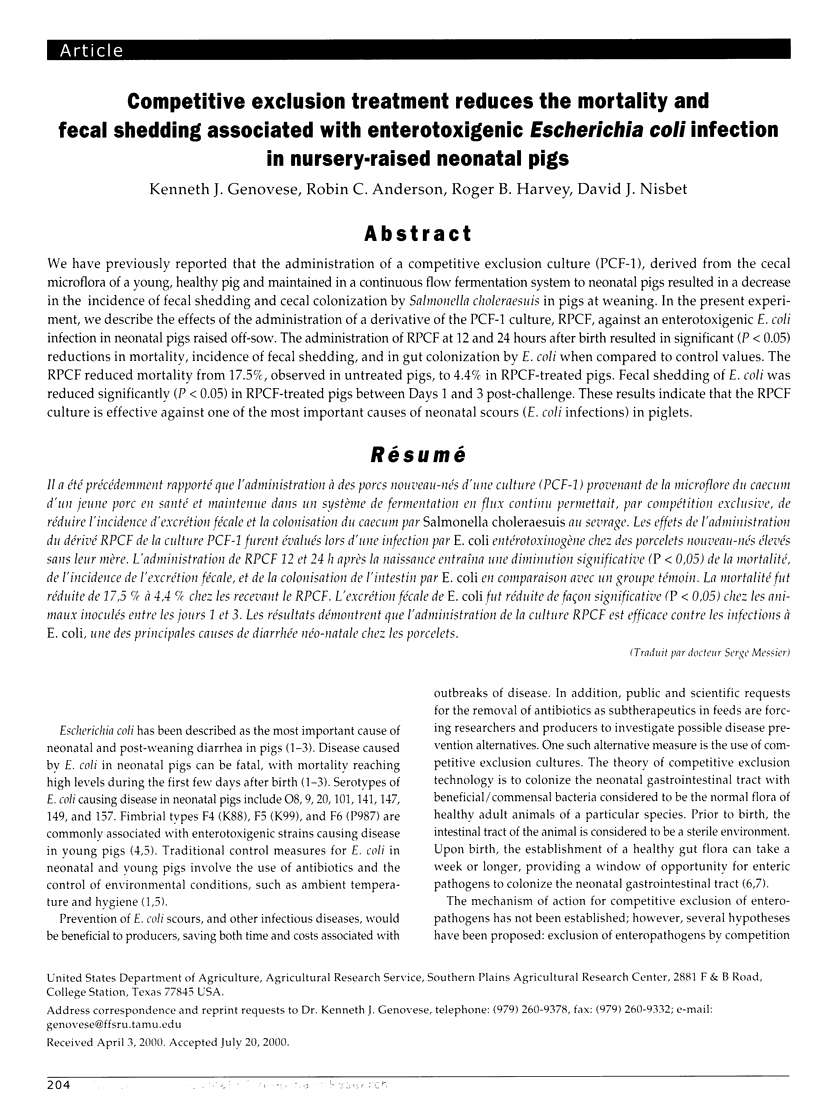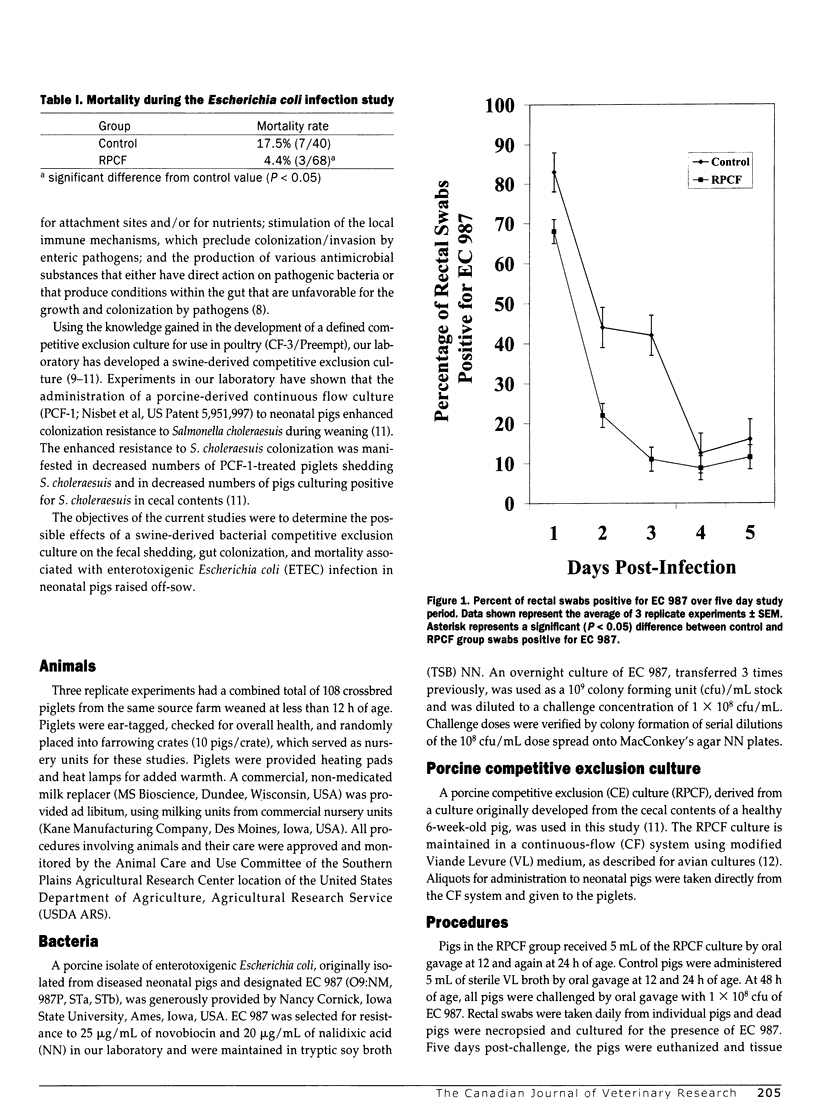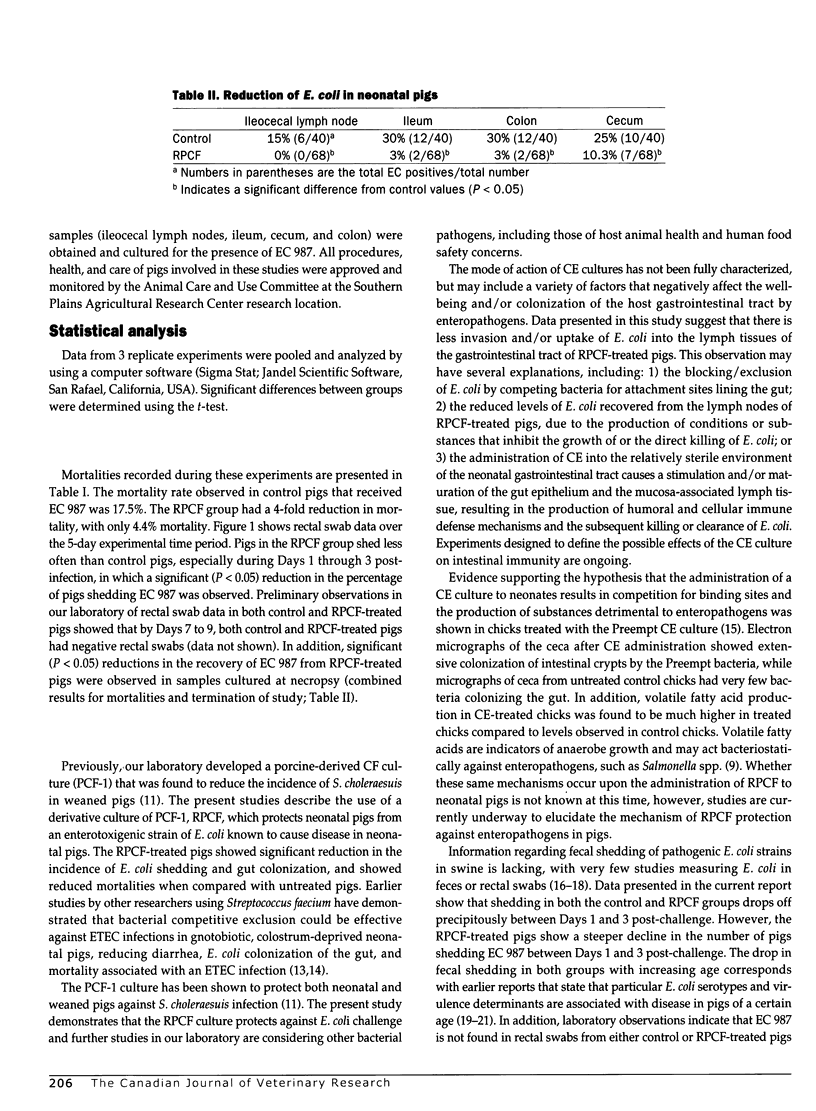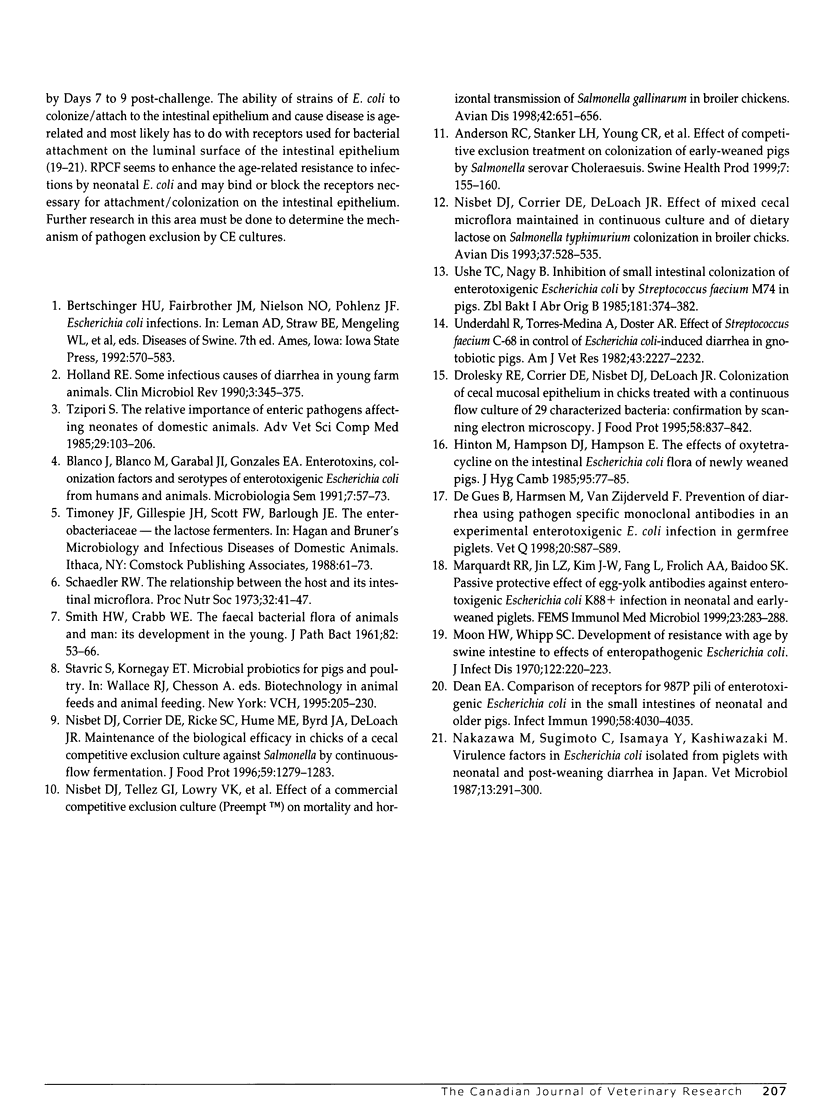Abstract
We have previously reported that the administration of a competitive exclusion culture (PCF-1), derived from the cecal microflora of a young, healthy pig and maintained in a continuous flow fermentation system to neonatal pigs resulted in a decrease in the incidence of fecal shedding and cecal colonization by Salmonella choleraesuis in pigs at weaning. In the present experiment, we describe the effects of the administration of a derivative of the PCF-1 culture, RPCF, against an enterotoxigenic E. coli infection in neonatal pigs raised off-sow. The administration of RPCF at 12 and 24 hours after birth resulted in significant (P < 0.05) reductions in mortality, incidence of fecal shedding, and in gut colonization by E. coli when compared to control values. The RPCF reduced mortality from 17.5%, observed in untreated pigs, to 4.4% in RPCF-treated pigs. Fecal shedding of E. coli was reduced significantly (P < 0.05) in RPCF-treated pigs between Days 1 and 3 post-challenge. These results indicate that the RPCF culture is effective against one of the most important causes of neonatal scours (E. coli infections) in piglets.
Full text
PDF



Selected References
These references are in PubMed. This may not be the complete list of references from this article.
- Blanco J., Blanco M., Garabal J. I., González E. A. Enterotoxins, colonization factors and serotypes of enterotoxigenic Escherichia coli from humans and animals. Microbiologia. 1991 Sep;7(2):57–73. [PubMed] [Google Scholar]
- Dean E. A. Comparison of receptors for 987P pili of enterotoxigenic Escherichia coli in the small intestines of neonatal and older pig. Infect Immun. 1990 Dec;58(12):4030–4035. doi: 10.1128/iai.58.12.4030-4035.1990. [DOI] [PMC free article] [PubMed] [Google Scholar]
- Hinton M., Hampson D. J., Hampson E., Linton A. H. The effects of oxytetracycline on the intestinal Escherichia coli flora of newly weaned pigs. J Hyg (Lond) 1985 Aug;95(1):77–85. doi: 10.1017/s0022172400062306. [DOI] [PMC free article] [PubMed] [Google Scholar]
- Holland R. E. Some infectious causes of diarrhea in young farm animals. Clin Microbiol Rev. 1990 Oct;3(4):345–375. doi: 10.1128/cmr.3.4.345. [DOI] [PMC free article] [PubMed] [Google Scholar]
- Marquardt R. R., Jin L. Z., Kim J. W., Fang L., Frohlich A. A., Baidoo S. K. Passive protective effect of egg-yolk antibodies against enterotoxigenic Escherichia coli K88+ infection in neonatal and early-weaned piglets. FEMS Immunol Med Microbiol. 1999 Apr;23(4):283–288. doi: 10.1111/j.1574-695X.1999.tb01249.x. [DOI] [PubMed] [Google Scholar]
- Moon H. W., Whipp S. C. Development of resistance with age by swine intestine to effects of enteropathogenic Escherichia coli. J Infect Dis. 1970 Sep;122(3):220–223. doi: 10.1093/infdis/122.3.220. [DOI] [PubMed] [Google Scholar]
- Nakazawa M., Sugimoto C., Isayama Y., Kashiwazaki M. Virulence factors in Escherichia coli isolated from piglets with neonatal and post-weaning diarrhea in Japan. Vet Microbiol. 1987 Apr;13(4):291–300. doi: 10.1016/0378-1135(87)90060-5. [DOI] [PubMed] [Google Scholar]
- Nisbet D. J., Corrier D. E., DeLoach J. R. Effect of mixed cecal microflora maintained in continuous culture and of dietary lactose on Salmonella typhimurium colonization in broiler chicks. Avian Dis. 1993 Apr-Jun;37(2):528–535. [PubMed] [Google Scholar]
- Nisbet D. J., Tellez G. I., Lowry V. K., Anderson R. C., Garcia G., Nava G., Kogut M. H., Corrier D. E., Stanker L. H. Effect of a commercial competitive exclusion culture (Preempt) on mortality and horizontal transmission of Salmonella gallinarum in broiler chickens. Avian Dis. 1998 Oct-Dec;42(4):651–656. [PubMed] [Google Scholar]
- Schaedler R. W. The relationshp between the host and its intestinal microflora. Proc Nutr Soc. 1973 Sep;32(2):41–47. doi: 10.1079/pns19730013. [DOI] [PubMed] [Google Scholar]
- Tzipori S. The relative importance of enteric pathogens affecting neonates of domestic animals. Adv Vet Sci Comp Med. 1985;29:103–206. [PubMed] [Google Scholar]
- Underdahl N. R., Torres-Medina A., Dosten A. R. Effect of Streptococcus faecium C-68 in control of Escherichia coli-induced diarrhea in gnotobiotic pigs. Am J Vet Res. 1982 Dec;43(12):2227–2232. [PubMed] [Google Scholar]
- Ushe T. C., Nagy B. Inhibition of small intestinal colonization of enterotoxigenic Escherichia coli by streptococcus faecium M74 in pigs. Zentralbl Bakteriol Mikrobiol Hyg B. 1985 Dec;181(3-5):374–382. [PubMed] [Google Scholar]
- de Geus B., Harmsen M., van Zijderveld F. Prevention of diarrhoea using pathogen specific monoclonal antibodies in an experimental enterotoxigenic E. coli infection in germfree piglets. Vet Q. 1998;20 (Suppl 3):S87–S89. [PubMed] [Google Scholar]


